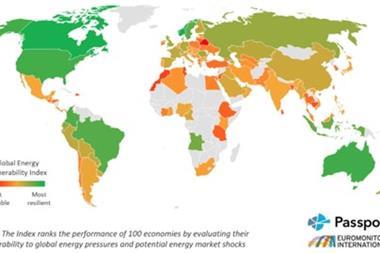You have identified 'systemic risk' as a new challenge for risk managers. What are the characteristics of systemic risk?
Ortwin Renn: This term denotes the embeddedness of any risk to human health or to the environment within the larger context of social, financial, and economic risks and opportunities. Systemic risks lie at the crossroads between policy-driven actions at domestic or international levels, and economic, social, technological or natural developments, including those altered by human action, such as the emission of greenhouse gases.
These systemic risks have highly complex ripple effects on different levels of the physical and social world. They are characterised by the uncertainty of their long-term effects, and their evaluation is likely to provoke a wide variety of different viewpoints and opinions.
It is the inter-penetration of the physical, environmental, economic, and social risks which is the most challenging topic in this area. These interrelated risk fields require a new form of risk analysis, in which data from different sources is integrated into one perspective. Systemic risk analysis requires a holistic approach, going beyond the usual agent-consequence analysis and focusing on the interdependencies and spillovers between risk clusters.
Systemic risks are characterised by three major challenges: complexity, genuine uncertainty, and ambiguity.
How have systemic risks evolved?
Ortwin Renn: They have evolved from the increased vulnerabilities and interconnections within the physical world as well as between sectors of society such as economic, social and political cultures. They are likely to become more prominent, due to a number of factors. These include increases in population and population density, the increased exposure of populations to natural hazards and technological risks, the increasing use of hazard-prone land for productive purposes, and the predicted increase of hazard intensity and frequency following on from human intervention in geochemical cycles.
Furthermore, at a time when the potential for disaster is growing, the ability of many societies to cope appears to be becoming less effective. Increasing urbanisation combined with insufficient speed in building supportive infrastructure is one factor. The coupling together of different risks, such as the interaction of natural disasters with chemical, technological, lifestyle, and social risks is another. Increased mobility and cultural dislocation, which brings in turn a loss of traditional management capabilities and an increase in social pressure is a third. Then there is an insufficiency in management capacity, and a lack of capacity for mitigation and contingency management.
Given these new challenges, we need a concerted effort to deal with systemic risks. In particular we need new approaches from the insurance industry to provide adequate tools for limiting and managing systemic risks.
Could you describe in more detail the impacts on risk assessment and risk evaluation?
Ortwin Renn: The German Advisory Council on Global Environmental Change (WBGU) addressed the issue of systemic risk management in its 1998 Annual Report. First it developed a set of criteria to evaluate risks, then evolved two sets of classification: one for risk identification, and one for risk management.
When looking at risk identification, for systemic risks, it is insufficient to investigate only the potential damage and its probability. Eight criteria were recommended by the expert panel
- Extent of damage - adverse effects in natural units such as deaths, injuries, production losses
- Probability of occurrence - estimate for the relative frequency of a discrete or continuous loss
- Uncertainty - overall indicator for different uncertainty components
- Ubiquity - the geographic dispersal of the potential damage
- Persistency - the time period of potential damage
- Reversibility - the possibility of restoring the status quo (eg reforestation and cleaning of water)
- Delay effect - the degree of latency between the initial event and the actual impact of the damage
- Violation of Social justice - the discrepancy between those who grasp the benefits and those who bear the risks
- Potential for social disruption - violation of individual, social or cultural interests and values leading to social conflict through the reactions of individuals or groups affected by the consequences of the risk
- inequity and injustice associated with the distribution of risks and benefits over time, space, and social class
- psychological stress associated with the risk or the risk source
- potential for social conflict and disruption (degree of political or public pressure on risk regulatory agencies)
- spillover effects: the likely consequences when highly symbolic losses have repercussions on other fields such as financial markets or loss of credibility in management institutions.
In terms of risk priority, risks with several extreme qualities play a special role. The Council has chosen a classification, derived from Greek mythology, where single risks are classified as risk types based on whether they reach or exceed one of these extreme qualities.
What risk management strategies should be adopted to handle these new challenges?
Ortwin Renn: For each of the six risk classes, special risk management strategies were developed. With respect to systemic risks, three different management regimes should be distinguished: classic risk management, dealing with risk avoidance and reduction; uncertainty and vulnerability management, dealing with measures to improve resilience; and ambiguity management, dealing with social concerns and spillovers from the physical to the social-cultural world.
In order to meet the needs of the three types of management, political action is needed. It should include:
- development of 'benign' technologies that do not aggravate the impact of natural disasters
- establishment of decentralised, flexible self-learning organisations
- the incorporation of economic incentives linking risk avoidance and risk reduction to monetary gains, via liability laws, mandatory insurance, tax incentives, bonus systems, and the like
- constant monitoring and early warning systems on a global level
- the establishment of a global panel to assess and manage risk with a network of existing risk organisations, a mandate to monitor natural risks worldwide, and the ability to consult risk managers in choosing best strategies.
Ortwin Renn: If society wants to cope with systemic risks, it must focus its effort on three major challenges: complexity, uncertainty, and ambiguity. Complexity refers to the difficulty in identifying and quantifying causal links between a multitude of potential candidates and specific adverse effects. The nature of this difficulty may be traced back to interactive effects among these candidates, long delay periods between cause and effect, intervening variables, and others. It is precisely these complexities that make sophisticated investigations necessary, since the cause-effect relationship is neither obvious nor directly observable. Complexity requires systemic assessment procedures and the incorporation of new mathematical tools, such as non-linear regression and fuzzy set theory.
Uncertainty is different from complexity. It has different and distinct components with one common feature: uncertainty reduces the strength of confidence in the estimated chain of cause and effect. If complexity cannot be resolved by scientific methods, uncertainty increases. Even simple relationships, however, may carry high uncertainty if either the knowledge base is missing or the effect is unpredictable by its very nature. If uncertainty plays a large role, the risk-based approach becomes counter-productive. Judging the relative severity of risks based on uncertain parameters does not make much sense. Under these circumstances, management strategies belonging to the precautionary or resilience based management style are required. The precautionary approach has been the basis for much of the European environmental and health protection legislation and regulation.
The last term is ambiguity or ambivalence. This denotes the variability of legitimate interpretations based on identical observations or data assessments. Most of the scientific disputes in the fields of risk analysis and management do not arise from differences in methodology, measurement or dose-response functions, but from the question of what it all means for human health or environmental protection. Again, high complexity and uncertainty correlate with ambiguity, but there are also quite a few simple and almost certain risks that can cause controversy, and thus ambiguity.
My understanding of systemic risks is that complexity, uncertainty and ambiguity are all associated with risks of this type. The causal chain is highly complex, encompassing different types of consequences, ranging from loss of life to financial losses. Secondly, these risks are linked to high uncertainty, sometimes even indeterminacy because they are based on non-linear relationships. Thirdly, the consequences can be different depending on status and economic well being. Until now, risk management agencies have not adequately addressed such systemic risks. What is clearly needed is a holistic and systemic concept of how to characterise, assess, and evaluate them. Additionally, we need to clarify what type of procedure is required for managing systemic risks to obtain effective, efficient and politically feasible risk reduction .
What are the lessons for the risk manager?
Ortwin Renn: To cope with systemic risks, management cannot be left just to risk management agencies. It is not sufficient any more to look into the liabilities and potential losses caused by a risk event. The event may trigger ripple effects that promulgate through a whole sequence of secondary and tertiary impacts, many of which may not be covered by insurance. Even so, the insurance industry may be exposed to strong public pressure to compensate victims on a voluntary basis.
The tendency of systemic risks to trigger ripple effects across traditional policy boundaries has fuelled much concern and fear, in particular among financial institutions. The assessment of probabilities and damages becomes fuzzier and thus less reliable for calculating premiums. Complex cause-effect chains have already made environmental insurance policies a lottery. The more risks turn out to be systemic, the less clear are the boundaries between the insured and non-insured part of potential losses.
There is another aspect that insurance companies need to take into consideration. Systemic risks are likely to be cross-border or even global. There is a lot of concern in the public perception of complex global interconnections. The recent, often violent, demonstrations against globalisation demonstrate the cultural divide between those who believe they will benefit and those who believe they will lose out. Insurance companies may be caught up in this conflict about the degree of globalisation. There may be a resurgence of regional cooperative protection systems as a counterpart to internationally-driven large insurance corporations.
Conventional risk management instruments are inadequate to cope with systemic risks. We need to develop a much better conceptual understanding of these risks, and we need better instruments to deal with the challenges of complexity, uncertainty, and ambiguity.



















